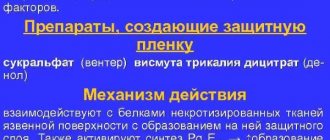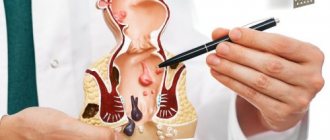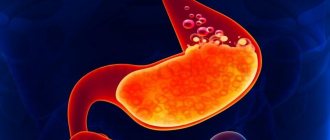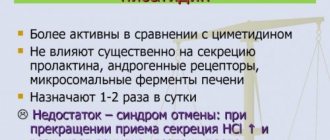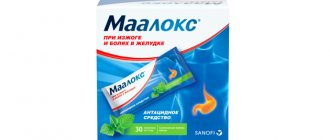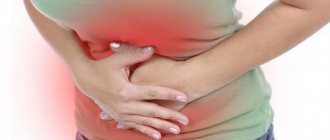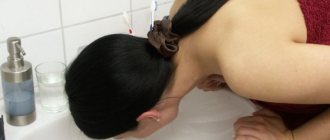Remedies for spasms in children are antispasmodic drugs (antispasmodics). Antispasmodics for children are a group of drugs that can eliminate excessive contraction of smooth muscle cells, that is, they can eliminate spasm. Spasms are quite common during early childhood. As a rule, they manifest themselves in pain, as a result of which the baby begins to cry. The severity of pain varies. Children can often be restless during the day and especially at night.
The main causes of spasms
The main reasons why doctors may recommend taking anti-spasm medications are:
- diseases of the esophagus, stomach, gall bladder, intestines;
- pathologies of the ureters, bladder;
- spasms of smooth muscles of the bronchi.
Spasms can also be caused by neurological diseases, including due to a deficiency of certain vitamins and minerals (for example, magnesium). It can occur as a side effect while taking certain medications or after stopping them.
The place of drotaverine among modern antispasmodics
Most often, pain and spasms are observed in diseases of the gastrointestinal tract (gastrointestinal spasms due to dyspepsia, colitis, cholecystitis, irritable bowel syndrome, etc.). A disorder of contraction of the smooth muscles of the gastrointestinal tract explains many of the symptoms encountered by therapists and gastroenterologists. Symptoms of spasmodic gastrointestinal dysfunction occur in almost 30% of people. Spastic pains are observed not only in diseases of the gastrointestinal tract, but also in urological and gynecological diseases. Understanding the pathophysiology of visceral spasm can facilitate a rational approach to treatment and choice of antispasmodic. Review of antispasmodics Antispasmodics represent a heterogeneous group of drugs; they differ in their mechanism of action and selectivity of action on different organs. Depending on the mechanisms of action, antispasmodics are divided into two groups: neurotropic and myotropic (Table 1) [1,2]. Neurotropic antispasmodics produce an antispasmodic effect by disrupting the transmission of nerve impulses in the autonomic ganglia or nerve endings that stimulate smooth muscles. The most important neurotropic antispasmodics are M-anticholinergic blockers. M-cholinergic blockers (atropine-like drugs) have a variety of effects on the muscle tone of various organs and the secretion of glands in which these receptors are localized. Thus, M-anticholinergics reduce the tone of the smooth muscles of internal organs (gastrointestinal tract, biliary tract, urinary tract, bronchi), reduce the secretion of hydrochloric acid in the stomach and other excretory glands (salivary, mucous, sweat), increase heart rate, cause mydriasis, paralysis of accommodation and increased intraocular pressure. The antispasmodic effect of M-cholinergic blockers on the gastrointestinal tract is carried out unevenly - mainly in the upper parts of the gastrointestinal tract (they reduce the tone of the stomach, pyloric sphincter, duodenum, gall bladder), which is associated with the unequal density of M-cholinergic receptors in the gastrointestinal tract and noncholinergic mechanisms for regulating the tone of the distal parts. Quaternary ammonium compounds that do not penetrate the BBB (methacin, chlorosyl) and have low systemic bioavailability when taken orally (hyoscine butyl bromide) have a more selective effect. Hyoscine butyl bromide exhibits its antispasmodic activity through its effect on the M1 and M3 subtypes of receptors, localized mainly in the walls of the upper gastrointestinal tract, gallbladder and biliary ducts, as well as blockade of H-cholinergic receptors (ganglionic blocking effect). For spasms of the lower gastrointestinal tract, it acts in doses 10 times higher than therapeutic doses. It is a relatively selective drug, since with increasing dose it loses selectivity, with the likely manifestation of typical atropine-like peripheral effects. Despite the minimal systemic availability of selective M-anticholinergics, they have unfavorable pharmacodynamic drug interactions with other drugs that cause anticholinergic effects (tricyclic antidepressants, antihistamines, quinidines). Anticholinergics are successfully used for abdominal pain caused by spasm in the upper gastrointestinal tract: dysfunction of the sphincter of Oddi, biliary dyskinesia, and pylorospasm [2,3]. However, some authors argue that hyoscine butylbromide has low effectiveness for biliary and renal colic and recommend it as an addition to analgesics [4]. Myotropic antispasmodics reduce muscle tone by directly influencing the biochemical intracellular processes that provide contractile activity: 1) change the content of intracellular cyclic nucleotides that regulate the concentration of intracellular Ca2+ (cAMP, cGMP); 2) directly change the current of Ca2+ ions into the cell through voltage-dependent or receptor-dependent calcium channels; 3) change the current of Na+ ions into the cell. The first mechanism includes phosphodiesterase (PDE) inhibitors (papaverine, drotaverine, etc.), the second - calcium channel blockers (pinaverium bromide, otilonium bromide), the third - sodium channel blockers (mebeverine hydrochloride). Myotropic antispasmodics exhibit a certain selectivity of action towards individual smooth muscle organs: they include gastrointestinal antispasmodics, bronchodilators, vasodilators, etc. PDE inhibitors are the most universal class of myotropic antispasmodics. Although they differ in selectivity and selectivity of action, which is ensured by the existence of numerous PDE isoenzymes in various types of tissues (tissue-specific and species-specific). Along with the antispasmodic effect on the gastrointestinal tract, urinary system, genital organs, bronchi and other organs, they have a minimal effect on the cardiovascular system. Drotaverine is a selective inhibitor of the PDE IV isoform, which is involved in the regulation of contractile activity of the intestine, urinary tract, and myometrium, which provides a high antispasmodic effect and selectivity of action. Drotaverine has additional mechanisms of antispasmodic action: blocking slow calcium channels, antagonism to calmodulin, blocking Na+ channels [5]. The pharmacodynamic effects of drotaverine underlie the pathogenetic action for the relief of acute spasmodic syndrome and long-term pharmacotherapy, for example, in chronic gastrointestinal diseases with spastic syndrome accompanied by colicky pain, dyskinesia of the bile ducts, cholelithiasis, as well as spasmodic syndromes in diseases of the urinary tract and pathologies of the genital organs. The lack of anticholinergic activity has a positive effect on the tolerability and safety of drotaverine, expanding the range of people to whom it can be prescribed, in particular, in elderly men with prostate pathology, as well as with concomitant pathology and co-administration with other drugs. Calcium antagonists with a predominant effect on the gastrointestinal tract include pinaverium bromide and otilonium bromide. The drugs have selective action on the gastrointestinal tract as a result of low systemic bioavailability (less than 10%), which practically does not cause systemic side effects characteristic of selective calcium antagonists. All of them have an antispasmodic effect not only on the upper gastrointestinal tract (stomach, pyloric sphincter), biliary system (sphincter of Oddi), but also effectively suppress peristalsis and spasms of the colon. The main use of calcium channel blockers, which act selectively on the gastrointestinal tract, is associated with irritable bowel syndrome (IBS). In the treatment of biliary pain they have no advantages over other antispasmodics. Myotropic antispasmodics include sodium channel blockers - mebeverine hydrochloride. By reducing the permeability of smooth muscle cells to Na+ ions through sodium channels, it helps limit the influx of Na+ and prevent the subsequent muscle spasm, thereby achieving an antispastic effect. Mebeverine also blocks the filling of the depot with extracellular Ca2+, which exhibits the properties of a calcium antagonist and complements the antispastic effect [2]. Mebeverine has the most selective effect predominantly on the gastrointestinal tract as a result of low systemic bioavailability, therefore it is used mainly for functional diseases of the gastrointestinal tract (non-ulcer dyspepsia, IBS), as well as for secondary spasms caused by organic diseases of the intestines and biliary tract. Results of clinical studies of drotaverine (No-Shpa) Clinical studies of No-Shpa in gastroenterology. The very first placebo-controlled studies showed the effectiveness of No-Shpa for relieving acute pain in three groups of diseases: diseases of the biliary tract, gastrointestinal diseases (peptic ulcer, gastritis, etc.), renal colic. According to the results of these studies, a complete immediate antispasmodic effect with intravenous or intramuscular administration was observed in 60% and was absent in only 17.5% of patients, while in the placebo group the absence of effect occurred in 73% of cases [6]. Subsequent studies revealed the effectiveness of oral use of No-Shpa in the treatment of spastic pain in patients with gastric and duodenal ulcers. It was noted that the effect began in most cases within 5–6 minutes, and complete pain relief developed after 12 minutes. Long-term oral administration of No-Shpa at a dose of 80 mg 3 times a day. within 5–20 days in 78% of patients it led to the disappearance of pain. A Shanghai study (n=180) compared the effectiveness of drotaverine (No-Shpy) and atropine in the treatment of abdominal pain associated with diseases of the gastrointestinal tract and biliary system (1998). Drotaverine was prescribed intramuscularly at a dose of 40 mg, atropine at a dose of 0.5 mg; pain syndrome was assessed on a 4-point scale, the effectiveness criterion was a decrease in pain severity by 1 point within 60 minutes. According to the study results, drotaverine led to a decrease in pain severity from 2.21 to 0.43 points (p<0.01), atropine - from 2.15 to 0.51 points (p<0.01). Differences in the main criterion of effectiveness between drugs were not significant; at the same time, pain relief developed faster with the use of drotaverine than with atropine: the average speed of the effect was 18.3 and 29.7 minutes. respectively (p<0.05), and the range of time to achieve effects was 5–40 and 15–60 minutes. respectively. There were also significant differences in the tolerability of the two drugs: the use of atropine was accompanied by a high frequency of characteristic side effects (dry mouth - 68%, hot flashes - 46%, palpitations - 31%, dizziness - 8%), while the use of drotaverine was only in 4% of cases accompanied by side effects (p<0.01). In a small study of 30 patients with abdominal pain syndrome caused by various gastrointestinal diseases (gastritis/gastroduodenitis, biliary dyskinesia, cholecystitis, colitis, pancreatitis), the dynamics of pain were assessed (on a 5-point scale) using No-Shpa 80 mg [ 7]. The severity of pain in patients averaged 3.2 points and was mostly moderate (73.3%). No-Shpa was prescribed in injection form at 80 mg once or in tablet form (No-Shpa forte 80 mg) for 7 days (the average daily dose was 140 mg). The dynamics of pain syndrome during treatment with No-Spa 80 mg showed a significant decrease in pain intensity on the first day both after intramuscular administration of No-Spa to 1.8 points, and after oral administration to 1.8 points. A course of taking No-Shpa forte for 7 days was accompanied by complete relief of pain within 2 days (up to 1 point – no pain). As a result, clinical effectiveness (excellent and good) was 80% according to doctors and 73% according to patients. The high rate of onset of the antispasmodic effect is ensured by the pharmacokinetics of drotaverine. After oral administration, the peak concentration of the drug in plasma occurs between 45 and 60 minutes, and 50% absorption is achieved in 12 minutes, which characterizes drotaverine as a rapidly absorbed drug (Fig. 1) [8]. Thus, the tablet dosage form of No-Shpa is characterized by high bioavailability (60%) and a rapid onset of action, which also allows its use for relief purposes. Efficacy of No-Shpa for diseases of the biliary system. Dyskinesia in the biliary and pancreatic systems is a common cause of acute pain (biliary colic) and chronic pain. The mechanism of pain development is primarily associated with dysfunction of the sphincter of Oddi, spasm of the sphincter muscle fibers of which leads to increased pressure in the bile and/or pancreatic duct system. In a pilot study, the antispasmodic effect of drotaverine was studied in 6 patients with biliary/pancreatic dyskinesia who underwent a functional test with morphine [9]. The use of drotaverine at a dose of 80 mg before the administration of morphine showed relaxation of the sphincter of Oddi and prevented the development of pain. In a double-blind, placebo-controlled clinical study, the effectiveness of drotaverine was studied in 42 patients with pain syndrome due to sphincter of Oddi stenosis. Drotaverine was prescribed 80 mg 3 times a day. for 4 months; in the control group, patients received placebo. The use of No-Shpa showed a significant reduction in pain in 61% of patients and a small effect in another 22%, while in the placebo group the effect was observed in 47 and 17%, respectively. The results of these studies showed that No-Shpa is an effective remedy for spasms of the muscles of the biliary tract, and can be used both in monotherapy and in combination with antibiotics and surgical treatment methods. Clinical studies of No-Shpa in irritable bowel syndrome (IBS). IBS is a very common gastrointestinal disease and is observed in 10–15% of the population. IBS is a common reason for visiting doctors. Among drug treatment methods, antispasmodics occupy a leading position: the frequency of their use is 42%. Antispasmodics are used in all clinical variants of IBS and help control the symptoms of the disease (abdominal pain, stool frequency). Pain syndrome in IBS is not the main one and is associated with intestinal transit disorders; a likely cause of pain may be a decrease in the threshold of pain sensitivity. The effectiveness of No-Shpa in patients with IBS was studied in two studies. A randomized, double-blind, placebo-controlled study included 62 patients (age 50.8 years) with IBS and constipation [10]. Patients recorded their complaints daily for 2 weeks. before the start of treatment and for 8 weeks. treatment with No-Spa in tablets 80 mg 3 times a day. or placebo. During No-Shpa therapy, a significant decrease in abdominal pain was observed by 47%, while in the placebo group, pain decreased by 3% (p < 0.05). While taking No-Shpa, other symptoms also decreased, including flatulence (by 21% versus 6% on placebo). The effectiveness of treatment with No-Shpa, according to patients and doctors, was 62.5 and 70.8%, respectively, and in the placebo group – 48% each. In another randomized, double-blind study, the effectiveness of No-Shpa was studied in 70 patients aged 18–60 years with a diagnosis of IBS [11]. Patients received No-Shpu in tablets of 80 mg 3 times a day. compared with placebo for 4 weeks, and then patients were observed for an additional 4 weeks. after discontinuation of therapy. The results of the study showed that the use of No-Shpa significantly reduced the frequency and intensity of pain by 47% (p<0.001) and the severity of dyspepsia by 20% compared to placebo (p<0.001). In Russian practice, a retrospective analysis of the effectiveness of 3 antispasmodics was carried out in 120 patients with IBS in hospital conditions: drotaverine, mebeverine and hyoscine [12]. The dynamics of spasticity and pain syndrome were assessed in total scores after 24 hours, 3 and 7 days. The results of the study showed that No-Shpa had the most pronounced and rapid effect, which was significantly different from the effects of other drugs after 24 hours; with further treatment there were no significant differences in the severity of the effects. At the same time, pharmacoeconomic analysis revealed the advantages of using No-Shpa in patients with IBS during the entire period of hospitalization of patients: the costs of the drug and the total costs of treatment were less than when using mebeverine and hyoscine by 52 and 83%, respectively. Clinical studies of No-Shpa in urology. The use of antispasmodics in urology is associated with the relief of renal colic against the background of urolithiasis. Stones located in the ureters cause painful spasms, block the flow of urine and lead to stretching of the kidney capsule, causing severe pain. In these cases, antispasmodics can not only relieve renal colic, but also promote the evacuation of stones (lithokinetic therapy). The antispasmodic effect of No-Shpa in patients with renal colic caused by nephro- and urethrolithiasis was shown in early clinical studies. The peculiarity of the drug’s action was not only the relief of renal colic, but also the restoration of the passage of urine through the urinary tract. In a controlled study in 208 hospitalized patients with urethrolithiasis, the effectiveness of drotaverine and atropine was compared; in all cases, patients additionally received analgesics [13]. In patients, stones were detected mainly in the lower part of the ureters; the size of the stones ranged from 7 to 26 mm (maximum dimension). Spontaneous evacuation of stones occurred in 68% of patients receiving drotaverine and 55.6% of patients receiving atropine. Moreover, with the use of drotaverine, even large stones (more than 17 mm) passed away in 24%, while in the control group - only in 2% of cases (Table 2). The average frequency of attacks of renal colic per 1 patient in both groups did not differ (1.6 and 1.7, respectively); At the same time, the duration of the period before the evacuation of the stones was significantly shorter against the background of the use of no - shpa compared to control (4.6 days against 5.7 days, respectively). In 1999–2000 A large multicenter placebo -controlled clinical study was carried out to study the effectiveness of NO -SHPA for urolithiasis [14]. The study included 140 patients (an average age of 42.5 years) with ultrasound or radiological studies in kidneys and ureters. To stop renal colic, the drutaverin of iv at a dose of 80 mg or placebo was used. The analysis included 102 patients: 48 received drutaverin, 54 - a placebo. The main endpoint of the study was the assessment of the antispasmodic effect of the NO - ShPA for 3 hours. Efficiency was evaluated using the visual -analogue scale (range 0–10), a 5 -point scale of pain intensity and a 5 -point pain reduction scale; Efficiency criteria were a decrease in pain by 40% in your or 50% on a 5 -point pain of pain reduction. The effectiveness of the antispasmodic action of the NO - ShPA was 79%, in the placebo group - 46% (p = 0.001), and the decrease in the intensity of pain on 5- points scales was reliably more pronounced against the background of the use of NO -SHPA than on placebo (Fig. 2) . Reducing your pain in your own had reliable differences only after 20 minutes. According to a survey of patients, but - shpa was also more effective than placebo (81% versus 65%, respectively); The frequency of repeated administrations amounted to 42 and 65%, respectively (p <0.05). Clinical studies of but - gynecology. Gynecological disorders are often accompanied by severe pain due to spasm of the genitals. In a 4 -year observation study, the effectiveness of the use of drotaverine in 1400 women with various gynecological disorders (Table 3) was evaluated [15]. But - shpa was used in the form of injections or orally in doses up to 120 mg/day. The effectiveness of the NO - ShPA was noted in 81% of cases. It should be noted that the average daily dose can be 240 mg. In a recent multicenter, comparative double -blind study of Dorota in 323 women with dysmenorrhea, accompanied by severe or moderate pain, studied the effectiveness of NO -SHPA at a dose of 240 mg/day. and ibuprofen at a dose of 1200 mg/day. Within 3 days of the menstrual cycle (16). The severity of the pain was evaluated on a 4 -point scale for 6 hours after taking the drugs. The total decrease in the severity of the pain for the 6th hour of the period did not significantly differ in groups: –1.2 ± 1.18 amid the reception of NO -SHPA and -1.7 ± 0.99 against the background of Ibuprofen, although the proportion of patients with a good effect was more against the background of Ibuprofen (68% versus 42%). These results indicate the effectiveness of antispasmodics with dysmenorrhea in women. Pharmacoepidemiology of drotaverine (NO -SHPs) in Hungary conducted 2 consecutive large pharmacoepidemiological studies devoted to the study of the effectiveness of NO -SHPA in the pre -heating treatment of spasm of smooth muscles of various organs [17,18]. Research was carried out by analyzing medical documentation of the ambulance for the period 1982–83. (1st study, n = 4946) and since 1996–1997. (2nd study, n = 5934). The efficiency of but - for the relief of spasmodic symptoms and pain in emergency clinical practice was more than 70%. The greatest efficiency of but - was observed in patients with nephrolytias and renal colic, gastritis, abdominal colic, holes, dysmenorrhea (Table 4) [18]. The analysis of the dose dependence of the antispasmodic action of the NO -SHPA showed that for diseases of the gastrointestinal tract and gynecological disorders, effectiveness was achieved in most patients at a dose of 40 mg, while with spasms of bile and urinary tract, the most often required a dose of 80 mg (Table 5) [18]. An analysis of the velocity of the onset of the antispasmodic effect of NO -ShPA showed that the most rapid disappearance of spasm symptoms and pain was observed in the vast majority of patients for 20 minutes. (Table 6) [12]. The safety of but - in clinical studies, the safety analysis of the NUSSIA SAMS was carried out on clinical research for the period from 1964 to 1998. General and serious side effects were evaluated by organs and systems based on WHO classification. The analysis included 37 clinical studies, which included 14,818 patients - 12,111 received no - shpa. But - shpa was prescribed orally in doses of 120–240 mg/day., Injection in doses of 40–80 mg (maximum 120 mg) to stop symptoms or 20–40 mg/day. for supporting treatment. 108 side effects were described, the distribution of side effects by organs and systems is presented in Figure 3. The most frequent side effects, the frequency of which is more than 5%, were allergic reactions (17.6%), dizziness (11.1%), arrhythmia/palpitations (palpitations (palpitations (palpitations (palpitations (palpitations (palpitations (palpitations (palpitations (palpitations (palpitations (palpitations (palpitations (palpitations (palpitations (palpitations (heartbeat 6.5%), ataxia (6.5%), hemorrhage from the injection site (5.6%). The total frequency of side effects in accordance with the classification of WHO does not exceed 0.9%. There were no serious side effects associated with the use of NO - SHPA. Thus, over 76 clinical, observation and pharmacoepidemiological studies with the participation of 30,502 patients (30,034 adults and 468 children), of which 26,531, the patient received NO -ShPU were conducted [19]. The high efficiency and safety of the drug is convincingly proved. For the entire time of use of NO - more than 20 countries of the world, not a single case of a serious side effect has been registered. The conclusion of the NO - ShPA remains the most popular antispasmodic in clinical practice both for stopping spasms and pain, and for the treatment of diseases, accompanied by increased tone of smooth muscles. Drotaverin has a universal spectrum of action, regardless of the pathogenesis of pain and localization of spasms. The pharmacokinetics of the drug provides a high speed of achieving a bought antispasmodic effect even with oral use. Along with the high efficiency of NO - shpa, it differs in the best safety, tolerate well and does not cause significant cardiovascular reactions. In addition, the high efficiency of NO - SHPs is combined with efficiency with prolonged use.
Literature 1. Functional diseases of the intestines and biliary tract: issues of classification and therapy./ Int. Bulletin Gastroenterology 2001, no. 5, pp. 1–4. 2. Rational pharmacotherapy of diseases of the digestive system. / Ed. V.T.Ivashkina. M.: Litterra, 2003, 1046 p. 3. Shulpekova Yu.O. Comparative characteristics of antispasmodic drugs used in gastroenterologist practice. / Wedge. prospects for gastroenterol., hepatol. 2002, no. 5, pp. 6–11. 4. Holdgate A, Oh CM. Is there a role for antimuscarinics in renal colic? A randomized controlled trial. J Urol (Baltimore) 2005; 174:572–5. PubMed. 5. Tomoskozi Z., Finance O., Aranyi P. Drotaverine interacts with L-type Ca2+ channel in pregnant rats uterine membranes./ Eur. J. Pharmacol. 2002, v.449, p. 55–60. 6. Juhasz I., Palos LA Clinical value of No–Spa®./ Gyogyszereink 1964, v.14, p.219–225. 7. Leonova M.V., Shishkina T.I., Belousov Yu.B. New dosage form no-shpa forte in clinical practice. / Farmateka 2001, no. 12, pp. 20–21. 8. Bolaji OO, Onyeji CO, Ogundaini AO et al. Pharmacokinetics and bioavailability of drotaverine in humans./ Eur.J.Drug Metab.Pharmacokinet. 1996, v. 21, p. 217–221. 9. Pap A., Topa L., Balgha V. et al./ Gastroenterology 1997, v.112 (suppl), p. A519 (Abs). 10. Pap A., Hamvas J., Filiczky I., Burai M. Beneficial effect of drotaverine in irritable bowel syndrome./ Gastroenterology 1998, v. 114, p. G3359 (AGA Abs). 11. Misra SC, Pandey RM Efficacy of drotaverine in irritable bowel syndrome: a double-blind, randomized, placebo-controlled clinical trial./ Am.J.Gastroenterology 2000, v. 95, p. 2544 (Abs 455). 12. Afonin A.V., Drapkina O.M., Kolbin A.S. and others. Clinical and economic analysis of antispasmodics for the relief of abdominal pain caused by intestinal spasm. / RMJ 2010, vol. 18, no. 13, pp. 845–849. 13. Vecsey D. Results achieved by combined analgesic and spasmolytic treatment of patients with ureterolithiasis./ Urol. Nephrol. 1983, v.10, p.187–190. 14. Romics I., Molnar DL, Timberg G. et al. The effect of drotaverine hydrochloride in acute colicky pain caused by renal and ureteric stones./ BJU International 2003, v. 92, p. 92–96. 15. Czinkan T., Szabo S. Evaluation of NO–SPA® in the treatment of obstetric and gynecological cases./ Med.Univ. 1971, v. 22 (suppl. 4), p. 189–192. 16. Debski R., Niemiec T., Mazurec M., Debska M. Comparative efficacy and tolerability of drotaverine 80 mg and ibuprofen 400 mg in patients with primary dysmenorrhea – protocol DOROTA./ Ginec.Pol. 2007, v. 78, p. 933–938. 17. Maklari L., Tury P. NO–SPA® in the oxyological practice for the treatment of abdominal spastic conditions and acute cardiovascular cases. / Ther. Hung. 1989, Special issue, p. 3–20. 18. Maklari L., Tury P. Drotaverine (no-spa) in emergency medicine practice./ Klin. Pharmacology and therapy 1999, No. 2, 48–49. 19. Tar A., Singer J. Safety profile of NO–SPA®./ Orv. Hetil. 2002, v. 143, p. 559–562.
Groups and types of antispasmodic drugs
According to the type of effect, antispasmodics are divided into:
- Myotropic - act directly on smooth muscles. This group of antispasmodic drugs includes products based on papaverine, dibazole, aminophylline, theobromine, magnesium sulfate, drotaverine hydrochloride (No-Shpa 40 mg).
- Neurotropic - stops the occurrence of nerve impulses that cause spastic muscle contractions. Such drugs include, for example, atropine. Some drugs from this group affect the functioning of blood vessels, so they should only be prescribed by a doctor.
To eliminate spasms and the pain caused by them in childhood, it is most often recommended to take drugs of the first group (for example, based on drotaverine hydrochloride).
Types of medications for spasms:
- tablets, capsules;
- candles;
- solutions for injections (in ampoules).
Contraindications
Despite the diverse groups of antispasmodics, contraindications to their use can be generalized. Taking medications is contraindicated in the following cases:
- in case of individual intolerance to components;
- developmental defect with enlargement of the human colon (megacolon);
- acute inflammation of the intestines;
- atherosclerosis of cerebral vessels;
- pseudomembranous colitis;
- hyperthyroidism;
- muscle weakness;
- isolated neuropathies;
- acute intestinal poisoning, toxic infections;
- Down's disease;
- age under 18;
- pregnancy, breastfeeding.
Prevention of spasms
To avoid cramps, you should take care of your health:
- organize nutritious meals;
- take multivitamin and mineral complexes;
- study the effects of drugs recommended by doctors, take medications from trusted brands;
- do not forget about physical activity, restorative procedures, hygiene;
- ensure timely and correct treatment of any diseases, preventing their chronicity.
On the MIS Pharmacy 9-1-1 website, at any time of the day, you can select and order all the necessary goods and medical products with delivery in Kyiv and all cities of Ukraine at a competitive price. Simply place the selected items in your cart and confirm your order. Cosmetics and some types of medical equipment are also available. Choose!
Popular questions
What to drink for a spasm?
If your stomach hurts, you can take antispasmodics to reduce pain before seeing a doctor. They practically do not distort the clinical picture if the pain is caused not by a spasm, but, for example, by an inflammatory process.
Why are antispasmodics taken?
Antispasmodics relax the smooth muscles of the hollow organs of the human body. This allows you to establish their proper functioning, eliminate pain, and effectively treat the underlying disease (for example, removing stones from the kidneys).
Spasms can be not only a consequence of the disease, but also the cause of its development. For example, due to prolonged spasm of the biliary tract, obstructive jaundice may develop. Therefore, patients with chronic diseases of the respiratory system and gastrointestinal tract should keep a package of antispasmodics in their home medicine cabinet.
Side effects
The negative consequences of taking antispasmodics during and after treatment of diseases vary depending on the group of the drug, the method of administration, and the patient’s individual tolerance of the components.
M-anticholinergics have the following negative effects:
- from the immune system: anaphylaxis (up to shock), shortness of breath, skin rashes, itching, dyshidrosis resulting in eczema;
- from the heart, blood vessels: rapid heartbeat;
- from the digestive system: dry mucous membranes;
- from the genitourinary system – urinary retention.
Myotropic antispasmodics give side effects only with long-term use in the form of:
- allergies;
- drowsiness;
- vertigo;
- hypovolemia;
- electrolyte imbalance;
- dry mouth;
- epigastric pain;
- intestinal colic;
- flatulence.
It is extremely rare that intestinal obstruction and anuria occur during treatment.
When taking combined antispasmodics the following is noted:
- from the heart - allergic angina or heart attack, arrhythmias, hypotension (up to collapse);
- from the immune system - anaphylaxis (up to shock, death), angioedema, urticaria, bronchospasm;
- from the respiratory system - polyposis of the mucous membranes, sinusitis, attacks of bronchial asthma;
- on the skin – rashes of varying intensity and localization;
- from the blood, lymph - leukopenia, agranulocytosis, thrombocytopenia, anemia, pancytopenia with a fatal outcome;
- on the part of the vessels – collaptoid states;
- from the genitourinary system - blood in the urine, acute renal failure, interstitial nephritis.
Common adverse reactions from treatment with antispasmodics of any group:
- symptoms of intoxication, nausea;
- constipation;
- pupil dilation;
- accommodation paresis;
- blurred image;
- weakness, tiredness, fatigue;
- insomnia, nervousness;
- ataxia;
- confusion;
- decreased libido, potency;
- migraine.
It’s easy to minimize such effects: you should follow your doctor’s recommendations and instructions for taking the drug. Bronchodilators deserve special attention: the constant accumulation of secretions in the bronchi, as a result of the antispasmodic effect, provokes traffic jams and destruction of the bronchial tree.
The withdrawal of drugs occurs in stages, abrupt cessation of use is a reason for severe side effects and withdrawal syndrome.

